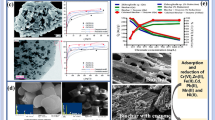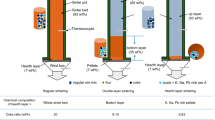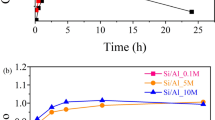Abstract
The low pH of acid rain can significantly affect the amount of solidified heavy metals that leach into contaminated soil. A series of laboratory tests were performed to better understand the pore structure and uranium (VI) leaching characteristics of solidified uranium tailings using different mineral admixtures under acid rain conditions. Different proportions of cement, slag powder, and metakaolin were combined to solidify the uranium tailings, and the samples were soaked for 0–60 days in a simulated acid rain solution. Nuclear magnetic resonance was used to measure the sample porosity before and after immersion, and the U(VI) concentration was measured using ultraviolet and visible spectrometry after immersion. The sample microstructures were tested by scanning electron microscopy. The sample porosities ranged between 3.4% and 6.5% and gradually decreased with increasing amount of mineral admixture. The U(VI) leaching rate and cumulative leaching fraction also gradually decreased with increasing admixture amount. The sample porosity increased with increasing immersion time and the U(VI) leaching rate initially rapidly decreased and then stabilized. The U(VI) cumulative leaching fraction and porosity were the lowest in the samples with 20% metakaolin, and the sample porosity and U(VI) cumulative leaching fraction showed an inverted S-shaped curve.







Similar content being viewed by others
References
Yin ML, Sun J, Chen YG, Wang J, Shang JY, Belshaw N, Shen CC, Liu J, Li HS, Linghu WS, Xiao TF, Dong XJ, Song G, Xiao EZ, Chen DY (2019) Mechanism of uranium release from uranium mill tailings under long-term exposure to simulated acid rain: geochemical evidence and environmental implication. Environ Pollut 244:174–181
Tan KX, Liu ZH, Xia LS, Lv JW, Hu HQ (2012) The influence of fractal size distribution of covers on radon exhalation from uranium mill tailings. Radiat Meas 47(2):163–167
Landa ER (2003) Mobilization of radionuclides from uranium mill tailings and related waste materials in anaerobic environments. J Radioanal Nucl Chem 255(3):559–563
Yukselen MA, Alpaslan B (2001) Leaching of metals from soil contaminated by mining activities. J Hazard Mater 87:289–300
Du YJ, Jin F, Liu SY, Chen L, Zhang F (2011) Review of stabilization/solidification technique for remediation of heavy metals contaminated lands. Rock Soil Mech 32(1):116–124
Liu ZP, Du YJ, Jiang NJ, Zhu JJ (2013) Leaching properties of cement-solidified lead-contaminated clay via semi-dynamic leaching tests. Chin J Geotech Eng 35(12):2212–2218
Ozga I, Bonazza A, Bernardi E, Tittarelli F, Favoni O, Ghedini N, Morselli L, Sabbioni C (2011) Diagnosis of surface damage induced by air pollution on 20th-century concrete buildings. Atmos Environ 45(28):4986–4995
Zhang G, Yang H, Ju C, Yang Y (2020) Novel selection of environment-friendly cementitious materials for winter construction: Alkali-activated slag/Portland cement. Journal of Cleaner Production 258. https://doi.org/10.1016/j.jclepro.2020.120592
Nguyen TS, Nguyen TS (2020) A Study on Eco-Concrete Incorporating Fly Ash and Blast Furnace Slag in Construction in Vietnam. Applied Mechanics and Materials 897:98–105
A. M, Md TH (2021) Characterization of mechanical properties by preferential supplant of cement with GGBS and silica fume in concrete. Materials Today: Proceedings 43(7):1179–1189
Diab AM, Elyamany HE, Elmoaty AEMA, Sreh MM (2019) Effect of nanomaterials additives on performance of concrete resistance against magnesium sulfate and acids. Construction and Building Materials 210:210–231
Ahari RS, Erdem TK, Ramyar K (2015) Permeability properties of self-consolidating concrete containing various supplementary cementitious materials. Constr Build Mater 79:326–336
Shi Z, Shi C, Zhang J, Wan S, Zhang Z, Ou Z (2018) Alkali-silica reaction in waterglass-activated slag mortars incorporating fly ash and metakaolin. Cem Concr Res 108:10–19
Saricimen H, Shameem M, Barry MS, Ibrahim M, Abbasi TA (2003) Durability of proprietary cementitious materials for use in wastewater transport systems. Cement Concr Compos 25(4):421–427
Jiang WY, Haver D, Rust M, Gan J (2012) Runoff of pyrethroid insecticides from concrete surfaces following simulated and natural rainfalls. Water Res 46(3):645–652
Hill J, Byars EA, Sharp JH, Lynsdale CJ, Cripps JC, Zhou Q (2003) An experimental study of combined acid and sulfate attack of concrete. Cement Concr Compos 25(8):997–1003
Zhao YX, Hou Q, Xu XB, Ding GA, Wang SF (2006) Spatial-temporal distribution of acid rain in China During. Clim Change Res 2(5):242–245
Liu X, Zhao WR, Meng MJ, Fu ZY, Xu LH, Zha Y, Yue JM, Zhang SF, Zhang JC (2018) Comparative effects of simulated acid rain of different ratios of SO42- to NO3- on fine root in subtropical plantation of China. Sci Total Environ 618:336–346
Du L, Li YX, Ma X, Liu YG (2015) Determination of micro uranium by arsenazo III spectrophotometry. Metall Anal 35(1):68–71
Yang S, Zhang XW, Wu XY, Li M, Zhang LJ, Peng Y, Huang QW, Tan WF (2019) Understanding the solid phase chemical fractionation of uranium in soil profile near a hydrometallurgical factory. Chemosphere 236. https://doi.org/10.1016/j.chemosphere.2019.124392
Tuzen M, Sari H, Soylak M (2004) Microwave and wet digestion procedures for atomic absorption spectrometric determination of trace metals contents of sediment samples. Anal Lett 37(9):1925–1936
GBT 7023-2011 (2011) Standard test method for leachability of low and intermediate level solidified radioactive waste forms. Standardization Administration of the People’s Republic of China, China, 2011
Yi YL, Qing XW, Zhuang Y, Liu SY, Du GY (2013) Utilization of GGBS in stabilization of soft soils and its mechanism. Chin J Geotech Eng 35(S2):829–833
Xie SD, Zhou D, Yue QX, Liu HL (1997) Influence of simulated acid rain on strength, crystal and pore structures of sand-lime slurry. Acta Sci Circum 17(1):26–32
Song FY, Gu L, Zhu NW, Yuan HP (2013) Leaching behavior of heavy metals from sewage sludge solidified by cement-based binders. Chemosphere 92(4):344–350
Yin CY, Shaaban MG, Mahmud HB (2007) Chemical stabilization of scrap metal yard contaminated soil using ordinary portland cement: strength and leachability aspects. Build Environ 42(2):794–802
Acknowledgements
This research was supported by the Research Foundation of Education Bureau of Hunan Province, China (grant no. 20A422), the National Natural Science Foundation of China (grant no. 11875164), Project Approved by Hunan Province Engineering Research Center of Radioactive Control Technology in Uranium Mining and Metallurgy and Hunan Province Engineering Technology Research Center of Uranium Tailings Treatment Technology (grant no. 2018YKZX1004), Open Fund Project of Hunan Cooperative Innovation Center for Nuclear Fuel Cycle Technology and Equipment (grant no. 2019KFZ01), Innovation Foundation for Postgraduate Set by University of South China (grant no. 203YXC006).
Author information
Authors and Affiliations
Corresponding author
Additional information
Publisher's Note
Springer Nature remains neutral with regard to jurisdictional claims in published maps and institutional affiliations.
Rights and permissions
About this article
Cite this article
Jiang, F., Wang, Z., Chen, G. et al. Experimental study of different admixture effects on the porosity and U(VI) leaching characteristics of uranium tailing solidified bodies in acid rain environments. J Radioanal Nucl Chem 329, 1375–1385 (2021). https://doi.org/10.1007/s10967-021-07887-6
Received:
Accepted:
Published:
Issue Date:
DOI: https://doi.org/10.1007/s10967-021-07887-6




